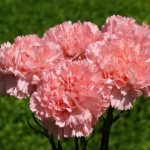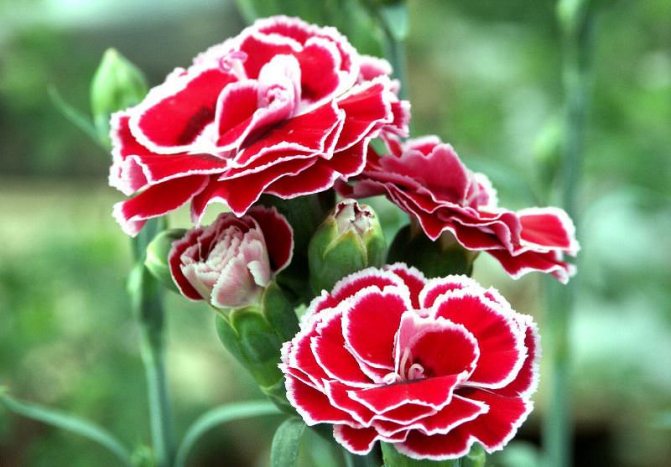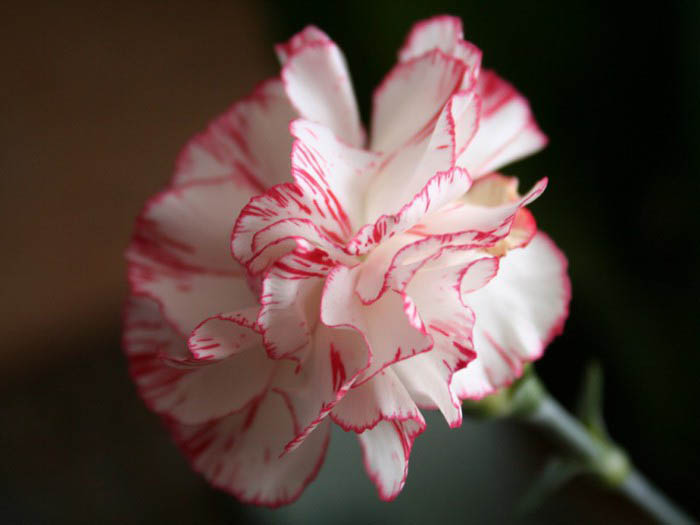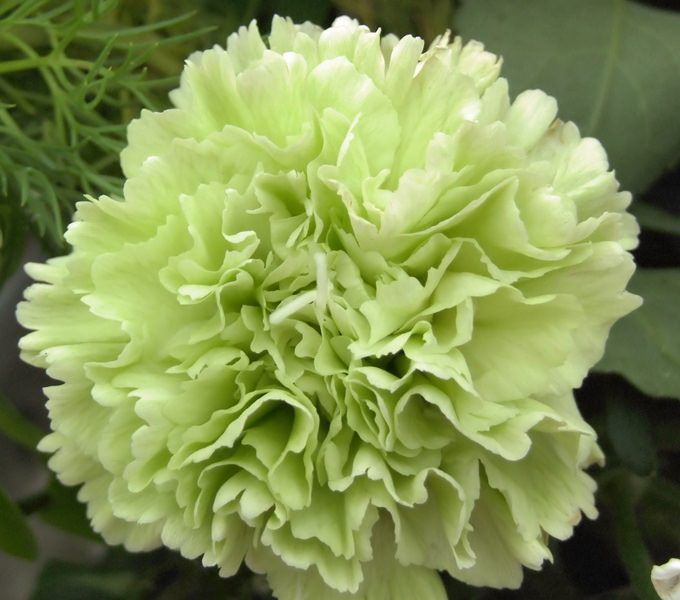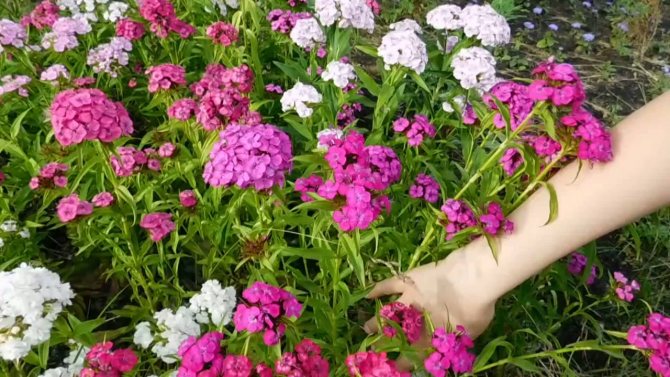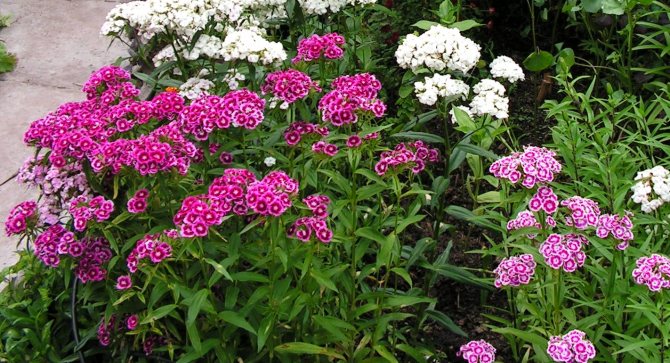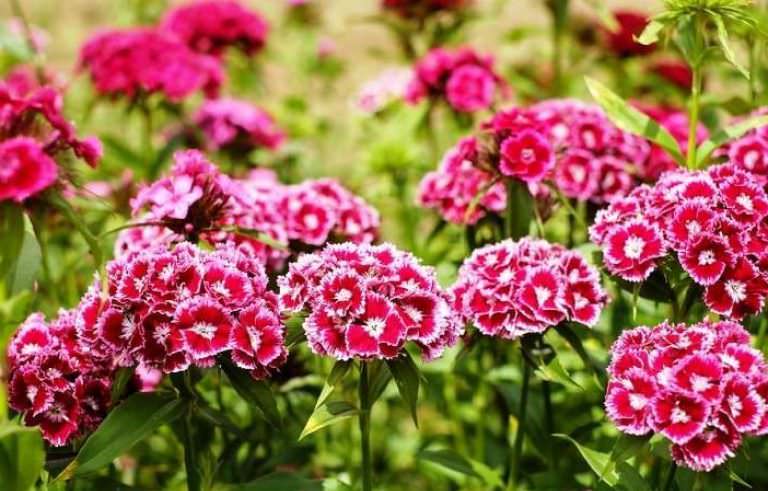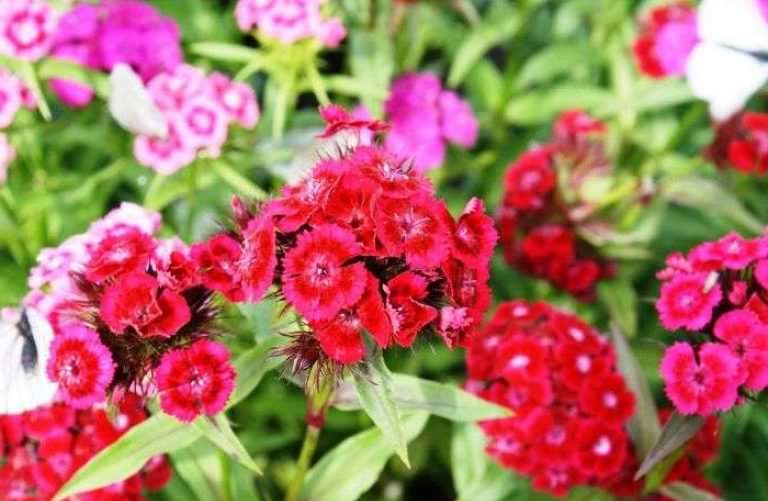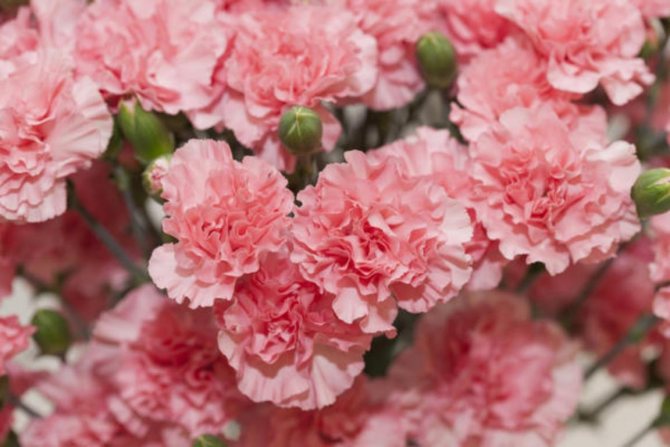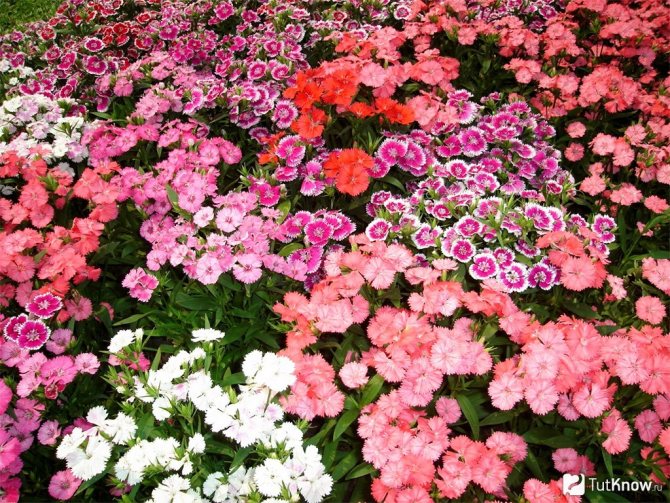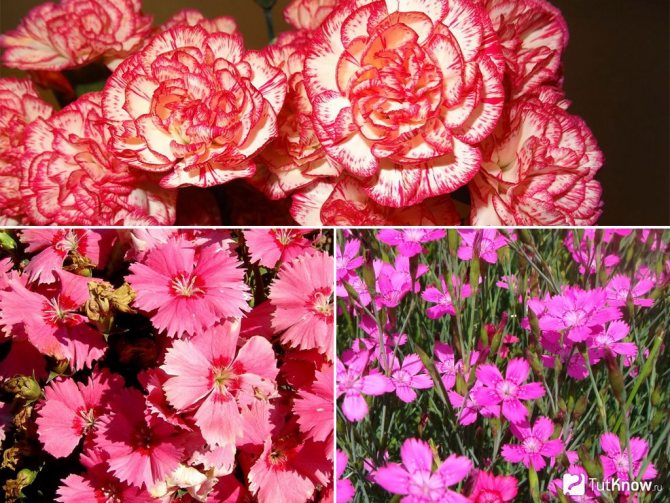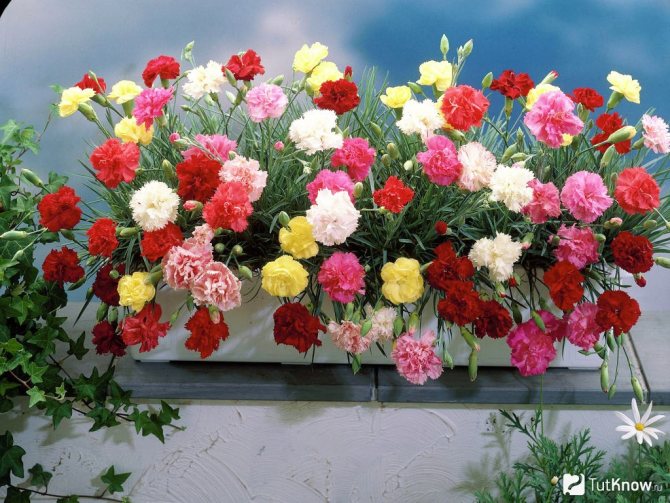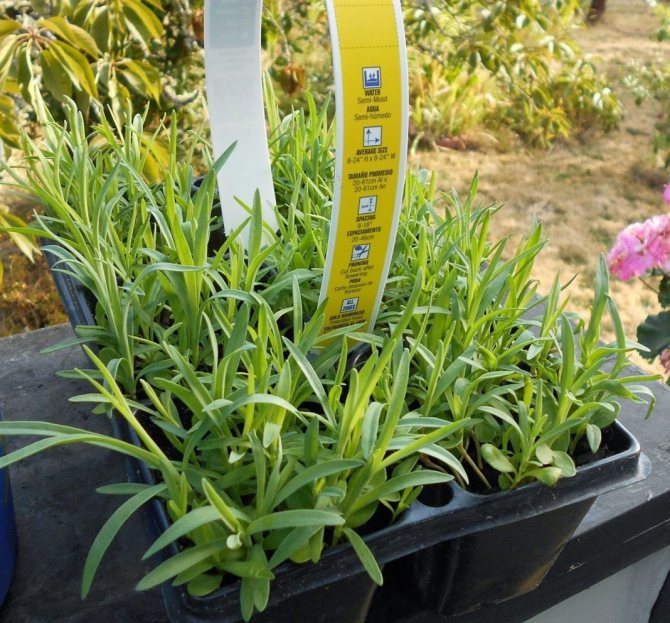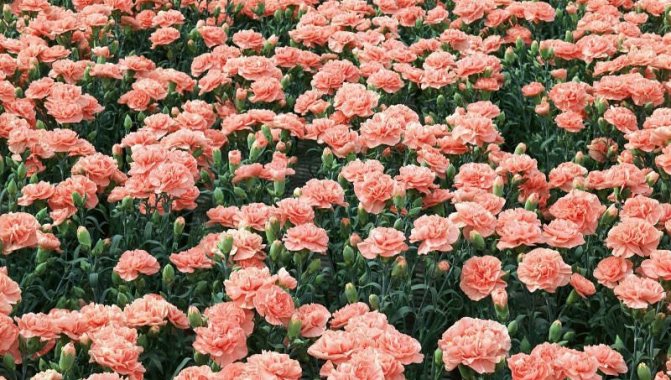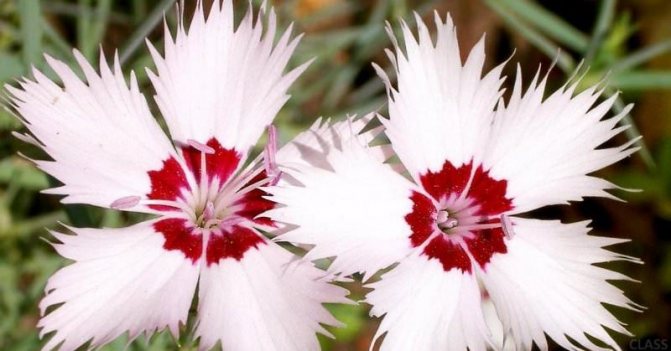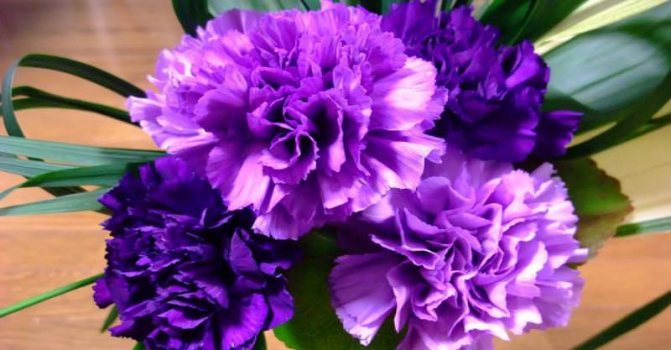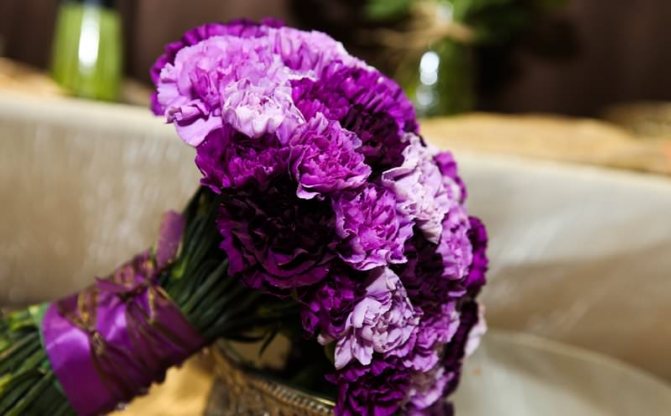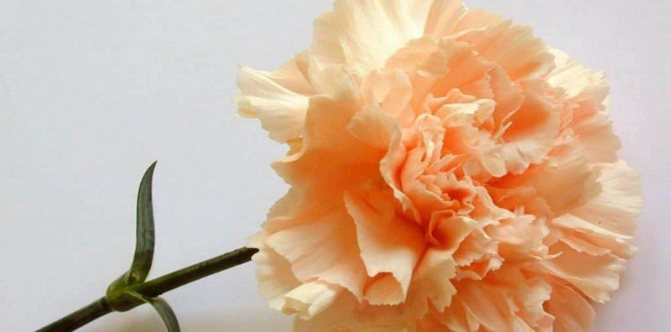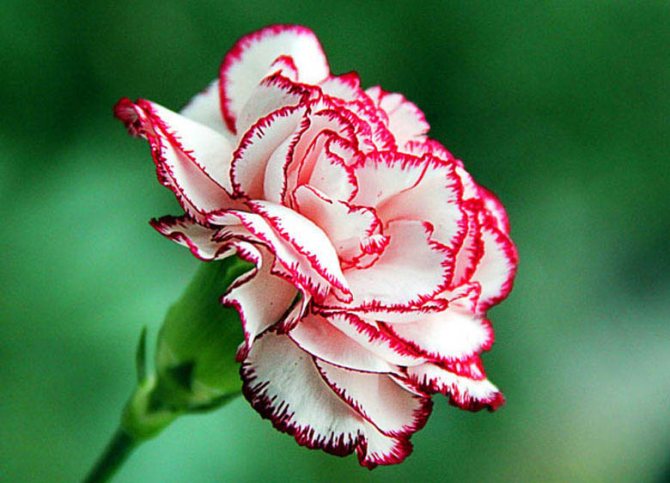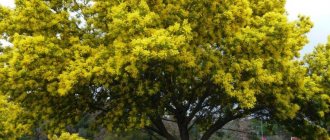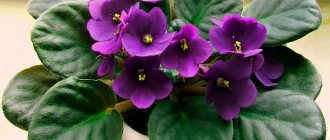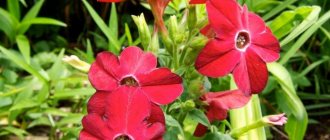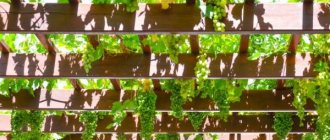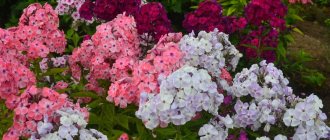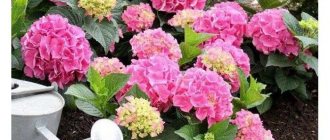Carnations are beautiful flowers, divided into many types: Chinese, Turkish, garden, indoor, spicy. This flower is quite popular with gardeners for its long flowering, variety of petal color, and unpretentiousness. It is not difficult to grow a carnation on your site or indoor pot, this plant ideally takes root as a perennial or as an annual, it all depends on the variety.
Carnation
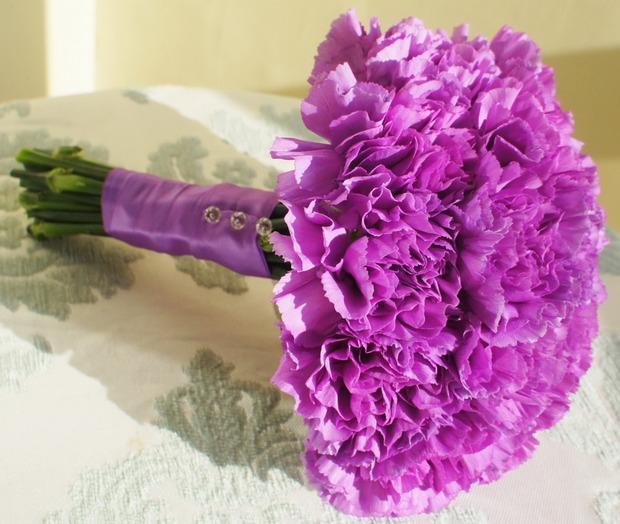
Lilac carnations on the table
Site selection and soil preparation
Most carnations prefer neutral or slightly alkaline soils, do not feel well on acidic and heavy soils. Flowers work best on fertile sandy loam and loam, moderately moist and fertilized.
Plants do not tolerate the introduction of fresh manure and spring stagnation of water, which is especially detrimental to perennial species wintering in the ground - grass, sandy, needle-leaved and gray carnations.
About these and other types of carnations, with a description and characteristics of the most popular varieties, read the article "Carnation - the best varieties and hybrids."
Plants love the sun and thrive in open-to-the-sun flower beds and flower beds, but they can also thrive in the light, rarefied penumbra of trellises and pergolas that cover plantings in the midday heat. This will keep the flowers longer and allow more lush shrubs to develop. At the same time, in the open sun the color of the petals is richer and brighter.
The area for planting seedlings or sowing seeds should be flat, protected from the wind, with grooves around the perimeter for moisture to drain. The soil during spring planting is treated in the fall, digging a shovel onto a bayonet and adding well-rotted manure or compost in an amount of 8-10 kg per 1 square meter. m, as well as lime on acidic soils.
It is not necessary to apply other fertilizers, and if in previous seasons the site was fertilized with manure, the soil is simply dug up, removing weeds and plant residues.
Growing Shabo carnations from seeds
Sowing Shabo cloves
For growing seedlings of Shabo carnations, a light substrate of a neutral reaction is used, for example, a mixture of sod or garden soil, peat, humus and sand in a ratio of 2: 2: 2: 1. Plastic containers, boxes, bowls, photo cuvettes, or any other low containers with drainage holes are suitable as utensils. The optimal height of the seedling dishes should be no more than 5-6 cm, since deep containers increase the risk of excessive dampness of the substrate.
- Fritillaria or hazel grouse
Seeds of Shabo carnations are sown for seedlings from the second decade of January to the third decade of February. Sowing earlier will require constant artificial lighting, while later sowing can push the carnation flowering back into late summer.
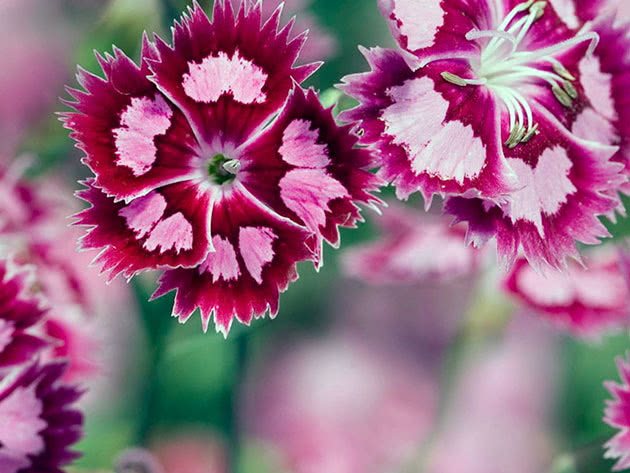

Shabo carnation seeds do not need pretreatment, but you can hold them in a growth stimulant solution - there will be no harm from this. Fill the seedling container with a damp substrate, level the surface, being careful not to press the soil too much, and spread the Shabo carnation seeds over the surface 1 cm apart. From above, the seeds are sprinkled with a layer of calcined sand 3-4 mm thick - this measure will save the seedlings from black leg disease. Cover crops with glass or foil.
Care of Shabo carnation seedlings
Shabo carnation seeds need special conditions for germination.The optimum temperature for this process is 15 ºC, but if your room is warmer, then place crops as close to the floor as possible. Do not let the substrate dry out, but you need to ventilate the crops and remove condensation from the film every day, since the seedlings of Shabo carnations are very sensitive to rot. Moistening of the substrate is carried out in the morning from a fine-dispersed sprayer, as soon as the top layer of the soil dries up.
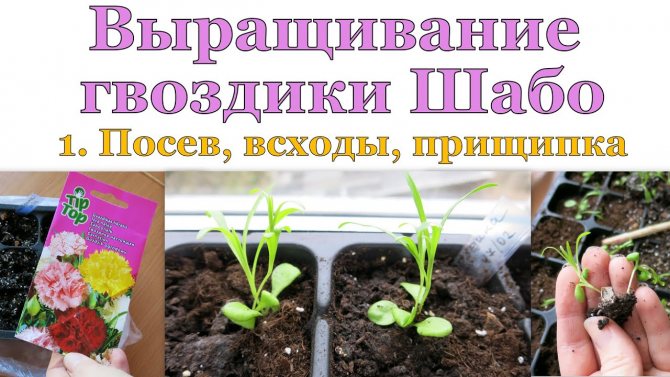

Seeds will begin to germinate as early as 4-5 days, and the mass emergence of seedlings will begin a week after sowing. As soon as the first shoots hatch, the film is removed, the crops are transferred to the southern windowsill and kept at a temperature of 12-13 ºC. Too long seedlings need to add soil mixture. Monitor the development of the seedlings, and if they begin to stretch, arrange artificial lighting for them for several hours a day. Remember to regularly ventilate the room without creating drafts. Watering should be scanty, keeping the soil slightly moist. Avoid waterlogging!
Picking a carnation Shabo
Due to sowing too early, Shabo cloves will need two picks. The first pick is carried out in the phase of formation of a pair of true leaves. Seedlings are planted in separate cups or seedling cassettes with cells with a diameter of 4 cm.The second pick is carried out approximately at the end of March at the stage of full development of four pairs of leaves: the plants, together with an earthy clod, are transferred into pots with a diameter of at least 10 cm.With each pick, the level of burial of the seedlings is preserved the same, and only if they are very elongated, deepen them no more than 2 cm.


When the seedlings form five pairs of leaves, the seedlings need to be pinched. If the plants look pale and grow very slowly, feed the seedlings over the leaves with low concentration nitrogen fertilizers.
- Fritillaria or hazel grouse
Immediately after the second pick, the Shabo carnation from the seeds is subjected to hardening procedures. The most popular way to adapt seedlings to the cold is to lower the night temperature by 10 degrees. For this, containers with seedlings are taken out overnight in an unheated room. When it gets warm, you can keep the seedlings under a film in a greenhouse, unless, of course, there is no night frost. You can take seedlings out into the garden in the sun during the day, away from wind and drafts, and bring them into a greenhouse at night until the air temperature at night rises to 7-10 ºC.
Breeding features
Carnations are propagated in two main ways: seminal - through seedlings or sowing into the ground, and vegetative - by cuttings, layering and dividing the bushes.
Seed reproduction
The method of seed propagation is effective for obtaining planting material of varieties Chinese carnation and Dutch varieties, succeed by sowing and Turkish carnation, sandy, gray and grass.
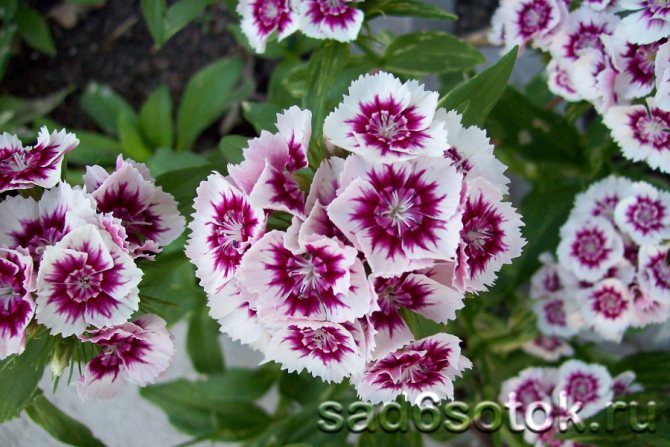

Turkish carnation (Dianthus barbatus)
Growing through seedlings gives an early lush flowering, for this the seeds of different types of carnations are sown at the following times:
- Shabo and the Grenadines - in January-February to greenhouses;
- Chinese - in March-April in greenhouses;
- Turkish - in May-June in hotbeds.
For sowing seeds of any kind, a nutritious soil is prepared, for which they mix:
- humus (compost) - 5 parts;
- sod land - 2 parts;
- sand - 1 part;
- horse peat (neutral reaction) - 2 parts.
The seedlings are kept at a temperature of 12‒15 ° C, good lighting and moderate watering with the obligatory descent of excess water. They are especially attentive to lighting in January-February, when there is a need for backlighting.
Chinese carnation when the fifth leaf appears, pinch it, which will give more lush bushes. Young plants Shabo transplanted twice - when the first true leaf appears and in the presence of four leaves in a mixture prepared according to the same recipe as for sowing seeds.
Many species work well sowing in the ground... It is important to consider that although plants love light and warmth, they are quite cold-resistant, but at the same time they cannot stand frost. Therefore, sowing begins in April-May, and if there is a threat of frost, the seedlings are covered with agrofibre.
Blooming in the second year turkish carnation, in addition to growing for seedlings in greenhouses, they are sown immediately to a permanent place in May-June, then thinning the seedlings every 15-25 cm.
Chinese carnation and species overwintering in the ground are sown in open ground in mid-April or in November as subwinter crops. Perennial undersized species - grass and sand give abundant self-seeding, and at the end of spring the bushes can be planted or, if desired, left there, allowing a dense flowering carpet to form.
Cuttings
Garden varieties and hybrids, in particular Shabo and the Grenadines, as well as turkish carnation, may not fully convey the selection differences, and therefore they are often propagated by cuttings. Seedlings often produce non-double or semi-double flowers, grow above or below normal.
Cutting carnations is a more laborious method of growing than seed, but this way you can get flowering plants of the desired quality and maintain the desired variety. In addition, all types of carnations root well and a sufficient amount of planting material can be grown.
Uterine bushes Shabo dug out in the fall, planting in pots, and at the beginning of winter, the shoots are pruned and the plants are stored in the basement. In mid-January, the bushes are brought into a lighted room or placed in greenhouses with a temperature of 12-15 ° C and watered. After a while, shoots begin to develop from the axillary buds, cuttings with 2-4 buds are cut from them.
An oblique cut of cuttings is treated with a root formation stimulant, for example, Kornevin, and planted in a light sandy loam soil mixture, covered with foil, glass or jars. Rooting lasts 2-3 weeks.
Division of bushes and layering
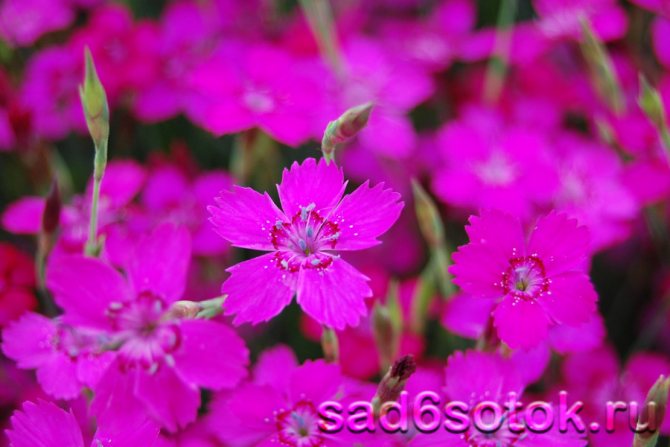

Carnation herb (Dianthus deltoides)
Perennial wintering species in the ground - grass, gray and feathery carnations, in addition to seed propagation and cuttings, can be successfully propagated dividing the bushes... To do this, in early spring, a section of sod with a root system and emerging shoots is carefully separated, and planted in a permanent place. After transplanting, the bushes are watered; under favorable conditions, the plants will bloom in the same year.
Reproduction layering possible for varieties with creeping shoots, e.g. shoots take root willingly grass and gray carnations... At the same time, it is possible to achieve the formation of roots on knotty shoots. Chinese carnation or Grenadine.
Long stems are pinned to damp soil with a curved piece of wire, sprinkled with damp earth and regularly watered. A sign of the formation of a new plant is the appearance of young shoots above the buried area.
The most famous types and varieties of cloves
Turkish carnation


Turkish carnation
This type of carnation is most commonly used for horticultural production. The biennial forms a lush bush up to half a meter high. Carnation flowers cover the entire surface of the bush in an even and dense layer, forming a colored cloud. This is one of the most popular types of this plant. The birthplace of the Turkish carnation is considered to be Southern Europe, where the flower has taken root in the wild.
Despite the fact that the Turkish carnation is a perennial, gardeners prefer to renew the plant every two years due to a sharp decrease in flowering. In the first year, the plant forms a lush bush, and in the second it begins to bloom profusely for several months.In the third year, the Turkish carnation practically loses all its decorative qualities.
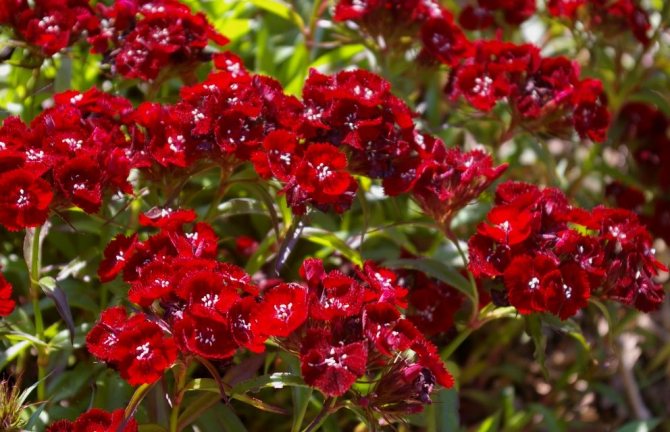

Turkish carnation
The most popular varieties of Turkish cloves include the following: Red Monarch, Kupferroth, Vice Risen, Mirage.


Turkish carnation (bearded)
Dutch carnation
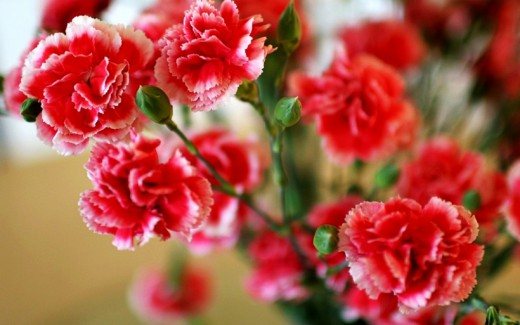

Dutch carnation
This type of flower is known to everyone, because it is he who is grown in greenhouses and sold in flower shops. The stems of the flowers are long - more than a meter, knotty, the leaves are small, narrow, dark green. The Dutch carnation is divided into three subspecies of varieties: tall (for sale), medium-sized and low-growing (for landscaping flower beds). It is from the Dutch carnation that Shabo and the Grenadines originated, which are considered to be separate types of flowers.
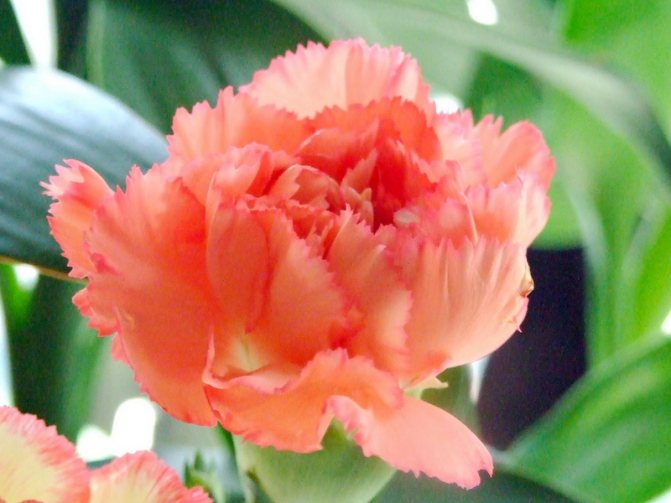

Garden carnation (Dutch)
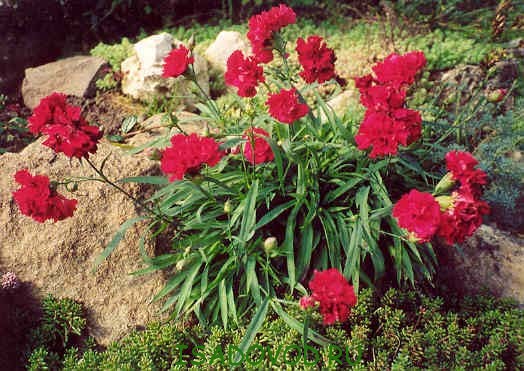

Dutch carnation in the garden
Carnation Shabo


Carnation Shabo
This type of carnation can be both an annual and a biennial, it all depends on the growing area. In the southern regions, this plant most often grows for two years, in regions with a temperate climate - one. This is a rather thermophilic species, but tolerates small frosts easily. The plant does not form a lush basket, the stems of this type of carnation are rather fragile, with a large number of nodes. The leaves are small, dark green in color. The flowers are fluffy, with a large number of petals, the diameter is up to 7 cm. The color of the flowers is very diverse, it all depends on the variety. Shabo carnations are very fragrant, characterized by a long flowering period, and when cut, retain their freshness in water for a long time.
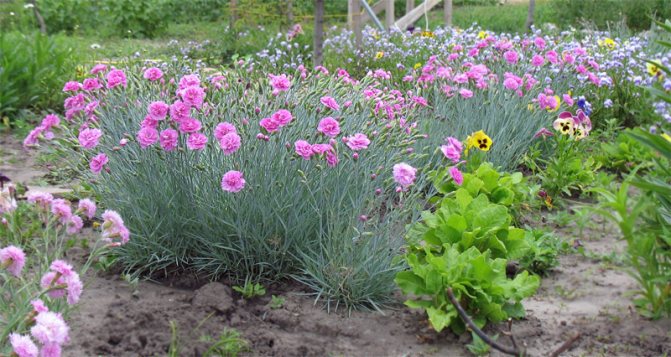

Shabo carnation in the garden
The most popular varieties of this species: Zhanna Dionysus, Aurora, Luminette Mix.
Carnation Grenadine


Carnation Grenadine
This type of two-year-old carnation is distinguished by its unpretentiousness and frost resistance, which makes it possible to grow flowers even in regions with a temperate climate. The plant is medium-sized - the stem height is no more than 45 cm. Carnations form a rather lush bush with a large number of knotty stems. A well-developed basket contains more than 180 stems with flowers. The flowers of this type of carnation are very large, strongly fluffy, with a wide range of colors. In the first year, a large basket is formed, the second year is distinguished by long and abundant flowering. The frost resistance of the carnation species allows it to winter in the ground without any consequences for the plant.
Chinese carnation
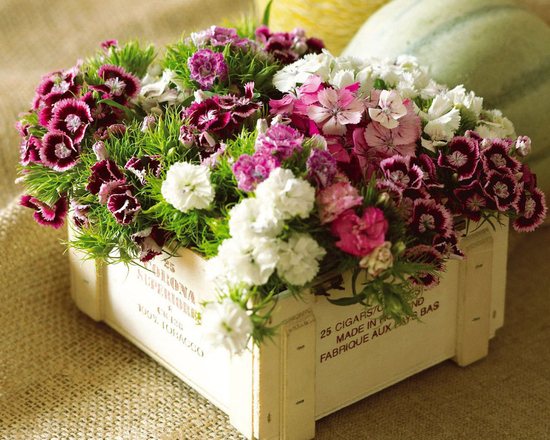

Chinese carnation
This type of annual plants is distinguished by its unpretentiousness, good germination and high flowering capacity. The height of the bush does not exceed 40 cm, the stems are knotty, with a large number of narrow leaves. The flowers are weakly double, 6-7 cm in diameter. The flower petals are paired, with denticles along the edge. The color of flowers is very variable, some varieties are multi-colored. A distinctive feature of the species is burgundy stripes along the petals.
Landing in open ground
Vegetative propagation of some types of carnations using cuttings is carried out throughout the season planting cuttings in open ground... This method simplifies the propagation process, making it less laborious, and allows you to get young plants in any quantity.
By the method of green summer cuttings, valuable varieties are most often propagated. Turkish and Grenadine carnations.
Green cuttings with 3-4 pairs of leaves are cut in late May or early June. An oblique cut is performed under the internode, treated with a root formation stimulator, sprinkled with foundationol powder and planted in a light soil mixture.
After planting, high humidity is maintained by covering the ridges with foil and spraying frequently. Rooting lasts 20-25 days, and in autumn the plants are planted in a flower garden.
Transplanting of all species in open ground is permissible not earlier than the threat of spring frosts has passed, that is, in mid-May. Plants are planted on a plot prepared in autumn, leaving the following distances between the carnation bushes:
- Shabo, Grenadines, Margaret - 30-40 cm;
- turkish - 15-25 cm;
- chinese - 20-25 cm;
- feathery, herbaceous, sandy - 25 cm.
If you want to create a continuous border or cover the soil with creeping flowering shoots, the gaps between the bushes for planting low-growing varieties are reduced to 10-15 cm.
They start planting in cloudy weather or, if this is not possible, plant seedlings in the evening. The plants are watered, the soil is mulched with high moor peat in half with sand.
Young plants obtained by layering are planted in a similar way, separating and placing in a permanent place no later than mid-June. Bushes grown by dividing the mother plants can be planted throughout the season, shading from the sun in the heat.
Carnation Shabo - description
The height of the Shabo carnation is from 30 to 70 cm. Its root system is pivotal, located at a depth of 10-20 cm. The shape of the bush is reverse-pyramidal with a well-defined main stem. Shoots are glabrous, knotty, rounded, gray-green in color. The leaves are also gray-green, narrow, up to 12 cm long and up to 7 mm wide. Large flowers can be simple, double or semi-double, of various colors, folded, corrugated, curved or deeply dissected. Simple flowers usually have 10 stamens, while double flowers can have up to 30 or more of them. The fruit of the Shabo carnation is a cylindrical multi-seeded capsule with five teeth, pointed at the end, in which small flat black seeds with a rough surface ripen.
Growing Turkish Cloves from Seeds
The perennial Shabo carnation is grown as an annual in our climate. We will tell you how to sow Shabo cloves for seedlings, how to care for seedlings, how to grow Shabo cloves outdoors, how and what to feed them, when to water, when to pinch Shabo cloves and how to protect them from diseases and pests.
Planting care


Shabo carnation (Dianthus caryophyllus var.shabaud)
Regular watering and feeding, protection from pests and diseases are the main methods of carnation care. In addition, weeds should be removed in time and seedlings should be thinned out during seed reproduction - weak young plants do not develop well in thickened plantings, and with the growth of perennial weeds, they may even die.
Watering
Plants are watered in moderation, many perennial species tolerate drought well, slightly losing their decorative effect. At the same time, varietal and hybrid varieties with large double flowers require regular watering - every 7-10 days at the rate of 7-8 liters of water per 1 square meter. m.
The next day after watering, loosening is carried out, destroying the crust, or the soil is mulched with peat or humus 5–7 cm thick in advance. This method will save moisture and improve the structure of the soil.
Fertilizer
Carnation is responsive to fertilizing, fertilized plants have more lush, thicker colored foliage and bloom brighter. A week after planting and at the beginning of flowering, complex fertilizers are applied.
In the first feeding, a composition is used with equal proportions of the main elements (nitrogen, potassium and phosphorus) or with a slight predominance of nitrogen. You can fertilize the flower bed with a mixture of the following composition:
- ammonium nitrate 6 g;
- superphosphate 10 g;
- potassium salt 3 g.
The increased phosphorus content will have a positive effect on the development of the root system. The proposed amount of fertilizer will be enough for feeding 10 sq. m landings. For the same purpose, you can use Kristalon yellow or green
During the budding period, dressings with a low nitrogen content and a high potassium content are used. During the season, it is enough to carry out two dressings. If the bushes Shabo will be transplanted into pots in the fall, the plants are fed again in early September.
Disease and pest control
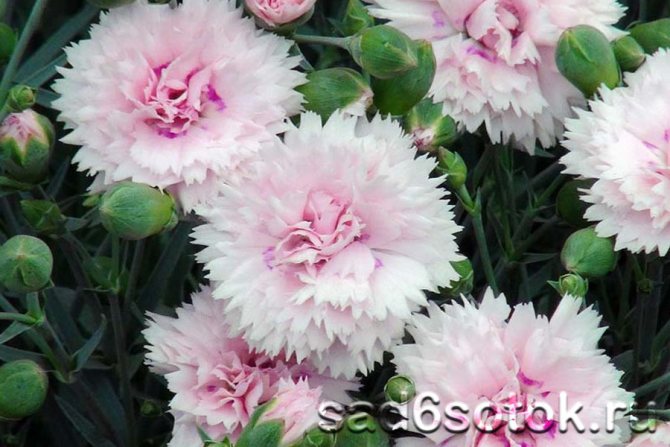

Pinnate carnation (Dianthus plumarius)
Perennial species carnations, if the rules of agricultural technology are observed, mainly in the absence of stagnant water, they rarely get sick.With seed reproduction at the stage of growing seedlings, varietal and hybrid plants can be sick with fungal and bacterial diseases, less often with viral infections. Of the fungal diseases, the greatest damage is caused by Fusarium, Alternaria and rust.
Fusarium manifests itself in the form of drying spots with a brown or black surface and a pinkish bloom on the stems of plants, more often at the root collar. Leaves and peduncles when affected by Fusarium turn pale and wither, and the plant quickly dies. To combat the disease, planting is treated with 0.1–0.2% suspension of foundationol, the same preparation is poured under the root, and the soil around the plants is sprinkled with dry powder.
Alternaria affects leaves and stems, characterized by the appearance of black spots, further drying out and loss of affected areas. To combat the disease, one of the fungicides is used - copper oxychloride, Ridomil or colloidal sulfur.
On defeat rust on the leaves, reddish pustules are formed in the form of small tubercles, in which the spores of the fungus develop, spilling out of the pustules as they mature and infecting everything around. Rust sick bushes are destroyed, plantings are treated with Topaz fungicide or copper oxychloride at least two to three times per season. If the lesion is observed in the greenhouse, carry out the same treatments and provide intensive ventilation.
A variety of pests of garden and flower plants can also cause damage to plantings - aphids, ticks, caterpillars, bears, wireworms, thrips other. In case of severe damage, pesticides are used - Decis, Bi-58, Arrivo. For treatments, it is advisable to use harmless herbal preparations based on wormwood, hot pepper, onions, garlic and pyrethrum.
So, when attacked aphids, thrips, ticks plantings are treated with onion infusion according to the following recipe:
- Take 200 g of chopped hot onions and pour 1 liter of boiled cold water (you can add a handful of onion husks).
- The drug is insisted for 15-16 hours, strained, squeezed and brought to a total volume of 8 liters.
Used for spraying plantings in the evening and morning hours.
Diseases and pests
Clove thrips
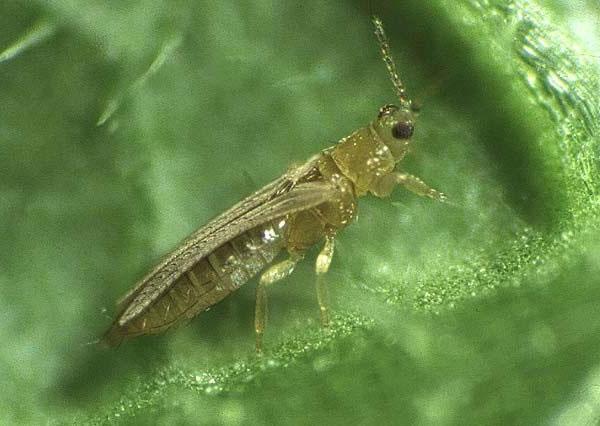

Clove thrips
This pest "specializes" only in carnations, it does not need any other flowers. The results of the activity of this insect are visible to the naked eye: the flowers begin to wither, the petals quickly begin to fall off. This is due to the fact that insects settle in the flower head and begin to suck the juices from it. Special pesticides help to get rid of aggressors.
Bears, scoops
These pests literally gnaw the flowers apart, completely destroying the receptacle. Also, stems and leaves of plants suffer from these insects. If you do not take action, then in a week the brood of insects is able to completely lime the flower garden.
Heterosporia


Heterosporium on cloves
The disease is caused by fungi. On all organs of the flower, spots of gray color appear, sometimes with a red border. If you do not take action, the spots begin to grow, coalescing. This leads to drying out and deformation of the plant. The fungus persists on all parts of the plant and pruning the bush will not lead to a cure, only special preparations can help.
Rust
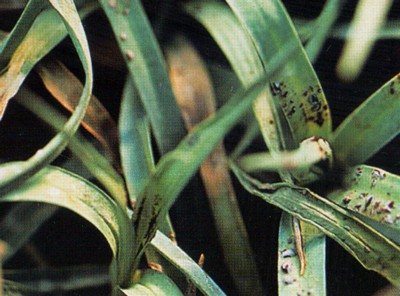

Rust
This disease is triggered by waterlogged soil or excess nitrogen. With rust, pads form on the undersides of the leaves, in which the spores of the fungus ripen. Once ripe, the pustules burst and spores infect other parts of the plant or spread to nearby bushes. When damaged by rust, the plant begins to dry out.
Growing carnations is not overshadowed by almost any problems. The only thing a gardener needs to know is that a carnation is a cross-pollinated plant, so it is not recommended to plant flowers of one variety next to flowers of another variety.
Shabo carnation at home
For a room culture, the Shabo carnation is an unsuitable flower: it is not for nothing that it is called a garden carnation. However, with the onset of cold weather, Shabo cloves can be dug up, planted in a pot and brought into a room where it will bloom until mid-November, or even longer. But it will require from you about the same conditions under which the seedlings are grown: cool content and very bright lighting. In the spring, the overwintered mother plant can be used for cuttings.
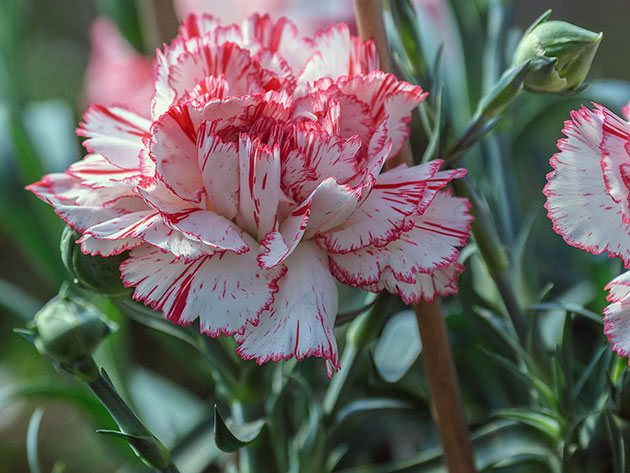

In a room culture, it is better to grow Chinese, hybrid and even Turkish carnations, and Shabo and the Grenadines, with the exception of some varieties, are plants for the garden.

